Properties
Zoro Lithium Project
Foremost Lithium’s Zoro Lithium Project, is located in west-central Manitoba, 571 km north-northeast of Winnipeg, approximately 20 km east of the town historic mining friendly town of Snow Lake. The area long history of extractive industries with excellent infrastructure: surrounded by operational mines, rail, power, and access to a skilled workforce.
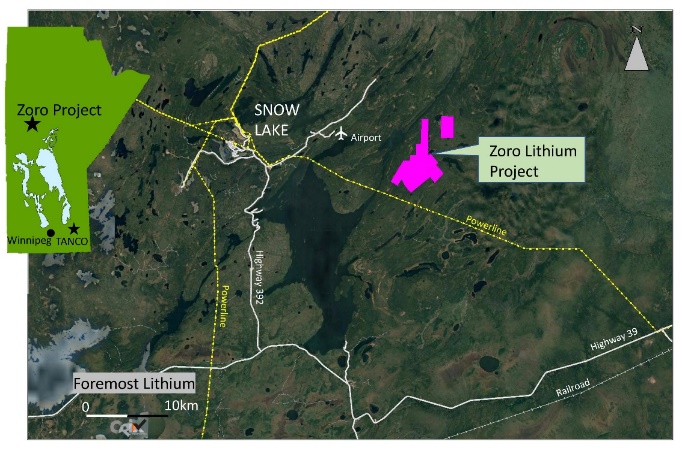
Figure 1: Zoro Property Location Map
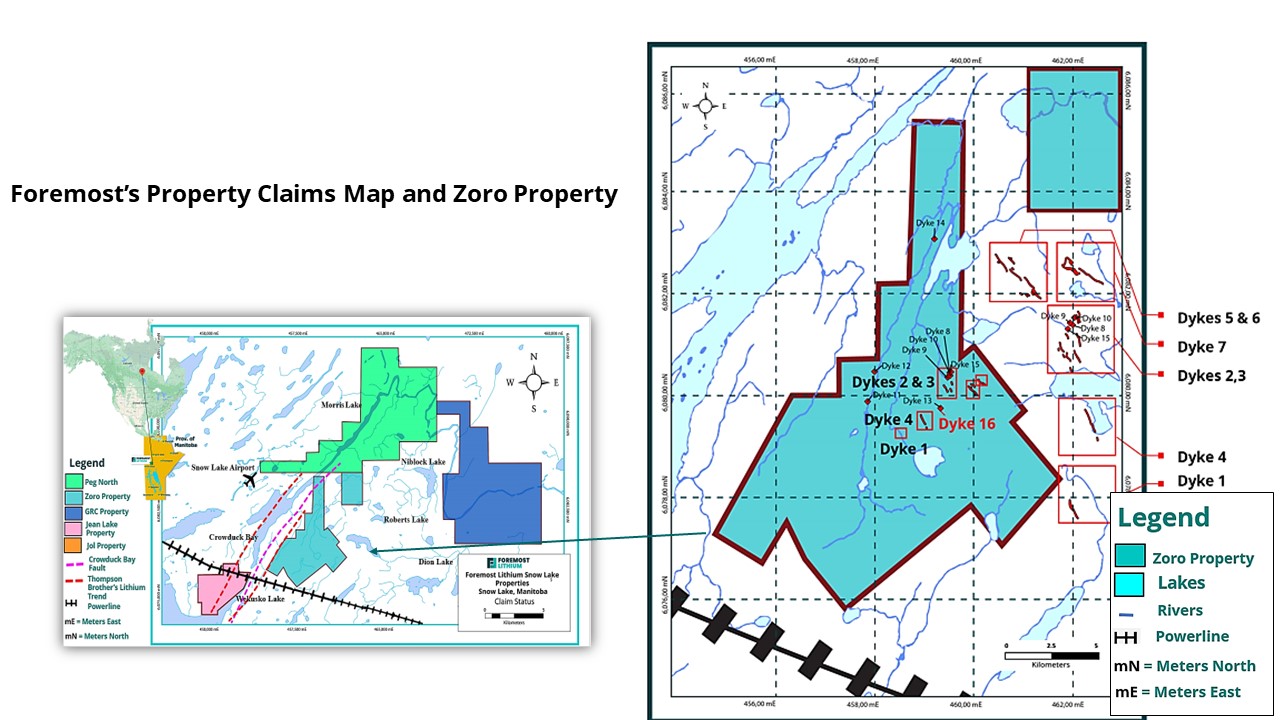
Figure 2: Foremost Property Map with Zoro Property Claims
The Zoro1 claim, that hosts the primary source of lithium on the property in Dyke 1, and the Green Bay and Manitoba options are 100% percent owned. Foremost owns the rights to 100% of the lithium resources. The 30 km2 property consists of 16 claims on a 8,377-acre, 3,390-hectare land package hosting 16 lithium-bearing pegmatites.
The Li2O inferred mineral resource estimate for the Zoro Property is 1,074,567 tonnes in situ at a grade of 0.91% Li2O, with a cut-off of 0.3% Li2O and metallurgical recovery of 90%. The inferred resource on the Zoro Property is entirely from a single high-grade lithium bearing spodumene pegmatite dyke (Dyke-1) partially outcropping at surface on the Zoro Property. Dyke 1 mineralization has demonstrated a 6% Li2O concentrate can be developed from low-iron, white to light green spodumene using industry standard methods.
Foremost has subsequently discovered a total of sixteen (16) spodumene mineralized pegmatite dykes which remain open for further drilling to build additional compliant resources. To date, pegmatite dykes exhibit excellent grades and drill-indicated widths, up to 1.4% over 49.8 m.There has been a total of eight drill programs completed on the property, totaling 15,000 metres in 80 holes drilled for $8.0 million in exploration to date.
On December 28, 2023, the Company announced a 30-hole winter drill program would commence on the property. Drilling is currently in progress, but assays were released on April 08, 2024 on two holes targeting Dyke 1 confirming 25.92 M of lithium mineralization including 1.09% Li2O across 10 M (see all details under "CURRENT DEVELOPMENTS" further down on page).
Access the link below to view the current NI 43-101 (known as the company’s previous name of Far Resources):
HIGH-QUALITY 6% BATTERY-GRADE LITHIUM HYDROXIDE
A preliminary metallurgical test was conducted to determine possible concentrate grade recoverable from the Zoro Dyke-1 deposit in 2020. In May 2022, Foremost Lithium contracted XPS Expert Process Solutions (a Glencore company) to develop a process to refine spodumene concentrate (SC6 technical specification) into a saleable battery-grade lithium hydroxide product. Foremost successfully completed its program to process an initial 500 kg mini bulk sample of spodumene-bearing pegmatite from Dyke-1 into a SP6 technical specification spodumene concentrate into battery-grade LiOH and Li2CO3.
Final test results confirmed in March of 2023 that Dense Media Separation (“DMS”) and flotation of DMS Middlings together, achieved a global lithium recovery of 81.6% at a spodumene concentrate grade of 5.88% Li2O. Pyrometallurgical and hydrometallurgical testing on the DMS spodumene concentrate have shown that the final product is amenable to a flowsheet, capable of producing both battery grade lithium products, Lithium Carbonate (Li2CO3) and Lithium Hydroxide (LiOH).
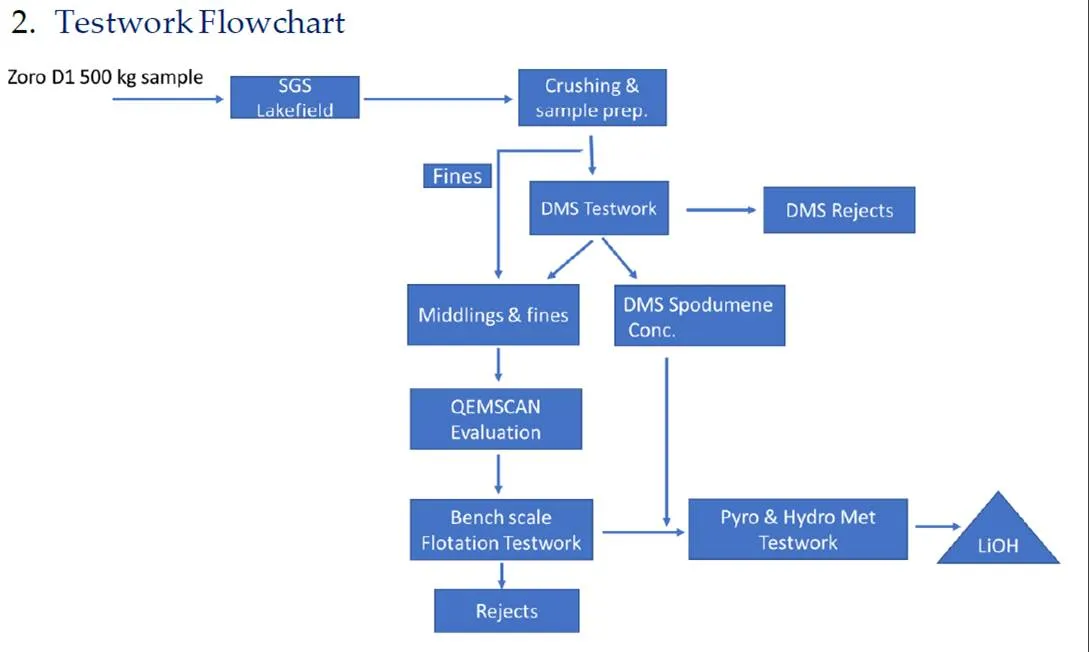
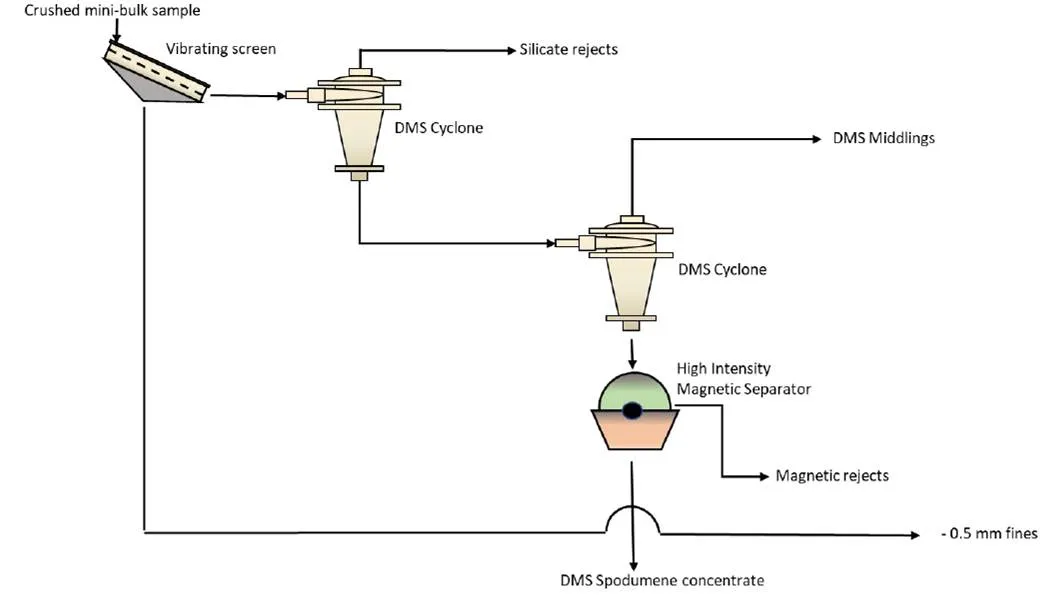
The Zoro Dyke 1 metallurgical program investigated the feasibility of lithium beneficiation by dense media and dry magnetic separation with the goal of producing a 6% Li2O concentrate from a Master Composite, at a fairly coarse particle size of -12.7/+0.5 mm. Completed HLS, DMS, and dry magnetic separation test work confirms that heavy liquid separation (HLS) demonstrates excellent potential for the recovery of an on-spec lithium concentrate from the Master Composite by dense media separations.
Timelines of this project:
Phase One – The HLS (heavy liquid separation) and DMS (dense media separation) test work concluded Dyke 1 spodumene ore is amenable for production. The bulk sample produced a final spodumene concentrate assaying 5.93% Li2O, with a lithium recovery of 66.9% in 26.5% mass after magnetic separation.
Results Released December 2022
Phase Two – Our DMS and flotation of DMS Middlings together achieved a global lithium recover of 81.6% at a spodumene concentrate grade of 5.88%, demonstrating that our spodumene concentrate is capable of producing both battery grade lithium products, lithium carbonate (Li2CO3) or lithium hydroxide (LiOH), while returning an extremely favourable OPEX/CAPEX to our Company.
Results Released March 2023
ZORO PROJECT EXPLORATORY 2022 DRILL PROGRAM

Figure 3. Zoro Property Displaying 16 Lithium Dykes
In April 2022, completed a 10-hole, 1,509 m drill program to test geological targets and Mobile Metal Ion soil geochemical anomalies. The Company announced newly discovered spodumene-bearing pegmatite dyke 16 on its Zoro property. The sixteenth dyke was intersected by two drill holes with intervals of up to 5 meters of 15% light green spodumene. A total of 8.28 m of spodumene-bearing pegmatite was intersected by two drill holes with highlight intercept of 1 m of 1.33% Li2O.
Dyke 16
Foremost Lithium announced newly discovered spodumene-bearing pegmatite dyke 16 on its Zoro property. The sixteenth dyke was intersected by two drill holes with intervals of up to 5 meters of 15% light green spodumene. A total of 8.28 m of spodumene-bearing pegmatite was intersected by two drill holes with highlight intercept of 1 m of 1.33% Li2O
Assay Samples
Samples were collected from drill core, photographs were recorded of core, both wet and dry and logged, and core samples were sawn in half, with one half of the core shipped to Activation Laboratories (Ancaster, Ontario) for assay.
Summary of 2022 Drill Results
| Hole ID | From (m) | To (m) | Width (m) | Li (ppm) | Li2O (%) | Cs (ppm) | Nb (ppm) | Ta (ppm) |
| Dyke 16 | ||||||||
| DDHFM22-070 | 32.44 | 33.24 | 0.80 | 203 | 0.04 | 296 | 137 | 86.6 |
| 33.24 | 34.00 | 0.76 | 1,040 | 0.22 | 226 | 116.2 | 89.7 | |
| 34.00 | 35.00 | 1.00 | 6,220 | 1.33 | 260 | 84.3 | 58.8 | |
| 35.00 | 35.80 | 0.80 | 4,000 | 0.86 | 253 | 97.1 | 47.4 | |
| DDHFM22-070B | 43.21 | 44.00 | 0.79 | 200 | 0.04 | 395 | 107.9 | 65.3 |
| 44.00 | 45.00 | 1.00 | 3,030 | 0.65 | 225 | 74.9 | 28.3 | |
| 45.00 | 46.00 | 1.00 | 4,890 | 1.05 | 319 | 113.3 | 35.7 | |
| 46.00 | 47.00 | 1.00 | 4,460 | 0.96 | 301 | 111.5 | 35.7 | |
| 47.00 | 48.13 | 1.13 | 4,030 | 0.86 | 476 | 106.5 | 61.9 | |
| Dyke 8 | ||||||||
| DDHFM22-071 | 70.45 | 71.30 | 0.85 | 563 | 0.12 | 328 | 99.9 | 63.1 |
| 71.30 | 72.30 | 1.00 | 4,030 | 0.86 | 384 | 57.1 | 30.2 | |
| 73.30 | 74.27 | 0.97 | 1,170 | 0.25 | 362 | 92.6 | 52.8 | |
| 75.20 | 75.89 | 0.69 | 659 | 0.14 | 565 | 135 | 55.2 | |
| 84.40 | 85.50 | 1.10 | 275 | 0.05 | 330 | 49.6 | 31.6 | |
| 85.5 | 86.65 | 1.15 | 246 | 0.05 | 414 | 62.8 | 34.3 | |
| 148.74 | 149.40 | 0.65 | 1,000 | 0.21 | 1,440 | 137.9 | 88.5 | |
| 150.76 | 151.70 | 0.94 | 440 | 0.09 | 777 | 67.3 | 32.8 | |
| 151.70 | 152.65 | 0.95 | 429 | 0.09 | 539 | 90.4 | 59.3 | |
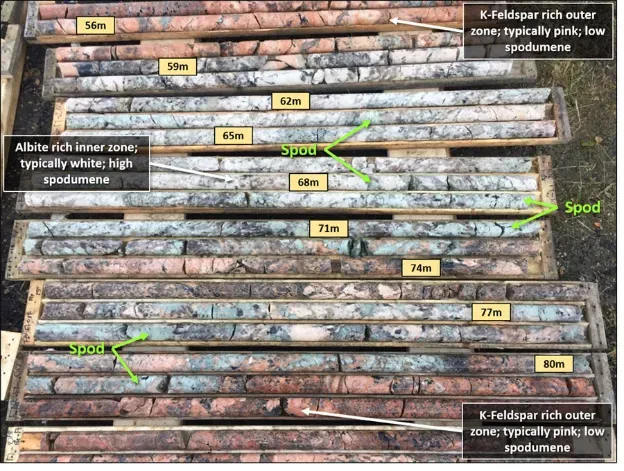
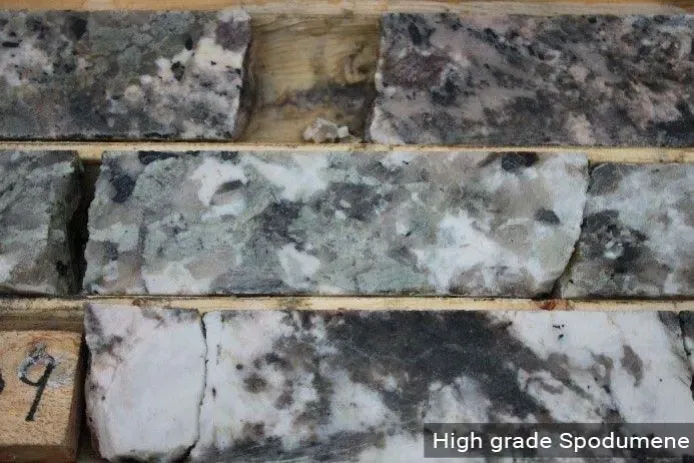
MINERALOGICAL AND CHARACTERIZATION
Light green to white spodumene mineralization occurs within laterally and vertically extensive pegmatite dykes hosted by mafic volcanic rocks and felsic sedimentary rocks indicating there are no preferred host rocks for the dykes The spodumene-bearing pegmatite dykes on the property strike northwest with steep dips and crosscut the regional foliation at a low angle. They are up to 800 m in length and 40 m in drill intersection. The dykes tend to be concentric in internal structure and constituent minerals include potassium feldspar, albite, muscovite, quartz, spodumene and black tourmaline.
Abundant overburden cover characterizes much of the property and the pegmatite dykes do not have a consistent recognizable geophysical signature although some dykes show an association with magnetic lows based on limited historic magnetic surveys . Many past spodumene-bearing pegmatite dykes have been discovered by drilling Mobile Metal Ions (MMI) soil geochemical anomalies on the property. The Zoro Lithium Project is underlain by ocean floor volcanic rocks of the Roberts Lake allochthon and lesser amounts of Missi Group sedimentary rocks. The Ocean Floor rocks comprise mafic volcanic and related intrusions and the Missi Group consists of sandstone, siltstone, mudstone, and quartzo-feldspathic gneiss and migmatite. The Ocean Floor mafic volcanic rocks adjacent to the pegmatite dykes consist of a fine to medium-grained strongly foliated dark green lithology. These andesitic to basaltic lithologies are locally interbedded with volcaniclastic sedimentary rocks and all are intruded by a quartz-phyric granite intrusion (Figure 3).
Pegmatite dykes generally strike northwest to north-northwest with steep dips and crosscut the regional foliation at a low angle. The dykes tend to be concentric in internal structure and the grain size of the constituent minerals (potassium feldspar, quartz, spodumene and black tourmaline) coarsens towards the center of the dykes. This pattern may be locally interrupted by patches of saccharoidal albite, large muscovite aggregates and coarse albite stringers with garnet and beryl. Spodumene may be concentrated in the cores of the dykes or homogenously distributed. Some of the dykes have been split into sub-parallel veins by post-emplacement tectonic activity.
You can read about the Mineralogical Characterization and Preliminary Beneficiation of the Zoro Lithium Project here: (known as Company’s previous name Far Resources):
![]() Mineralogical Characterization and Preliminary Beneficiation of the Zoro Lithium Project
Mineralogical Characterization and Preliminary Beneficiation of the Zoro Lithium Project
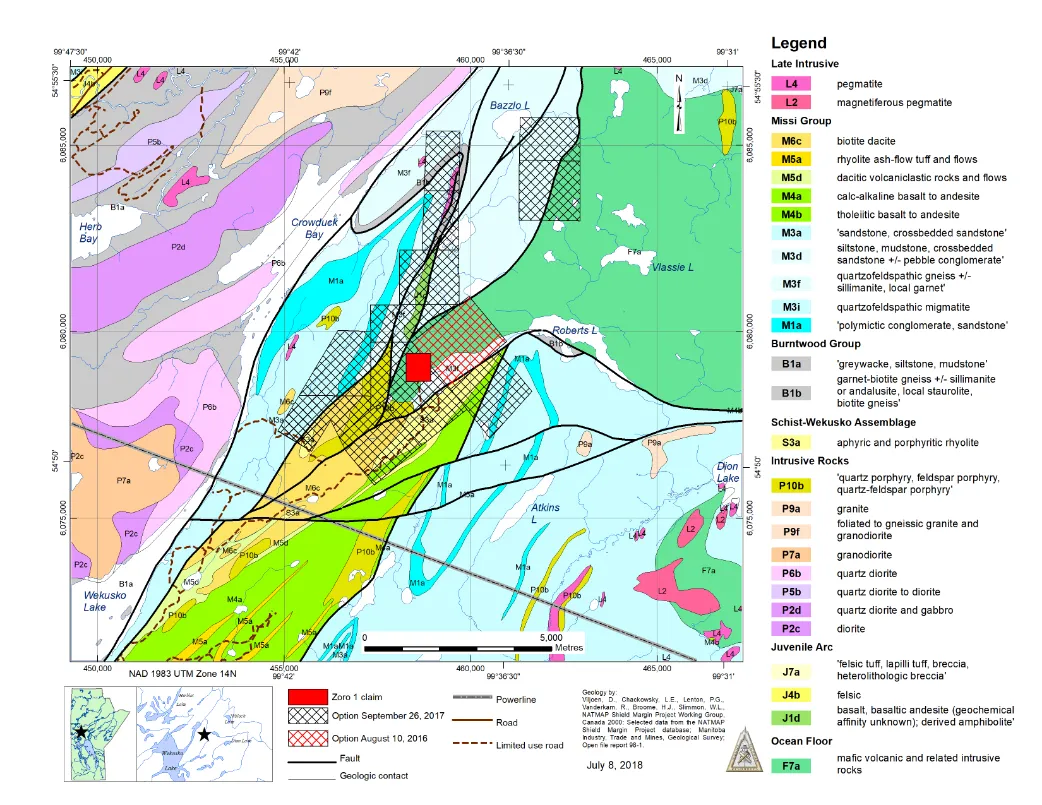 Figure 4. Geological setting of the Zoro Lithium Project with claim boundaries.
Figure 4. Geological setting of the Zoro Lithium Project with claim boundaries.
MINERAL DEVELOPMENT IN MANITOBA
Zoro is well situated in Manitoba with the potential for development. Manitoba is home to the world-class Tanco lithium-cesium-rare metal pegmatite at Bernic Lake. This mining-friendly province has a supportive, pro-business climate, mineral exploration assistance programs, and excellent access to geoscience and exploration data that will assist the company to advance its projects.
More than 98% of electricity in Manitoba is generated using hydroelectricity and wind, and access to abundant renewable power is sourced from the provincial grid. Additionally, the province has stable and well-developed mining and transportation infrastructure. The hydro line to Snow Lake is 5 km south of the property and the small historic gold mining community of Herb Lake is located about 10 km southwest of the property. A railway line is located at Wekusko, approximately 20 km south of Herb Lake. Electricity rates in Manitoba are reasonably priced and comparable to Québec.
Foremost Lithium is strategically located with proximity to North American electric vehicle and battery manufacturers, with robust existing infrastructure including the Arctic Gateway railway that runs to the south connecting via Winnipeg to the U.S. rail network for operational synergies and refining requirements
CURRENT DEVELOPMENTS
Exploration has been rapidly advancing on the Zoro Lithium Property. A drone-assisted magnetic and Lidar survey was undertaken by EarthEx Geophysical Solutions Inc (“EarthEx”) between May 28 and June 15, 2022, and comprised 1,264.7-line km. The related geoscientific database demonstrates sufficient technical merit to continue the assessment of known pegmatite dykes and assists exploration for repetitions of this style of mineralization. The completed UAV-assisted magnetic and LiDAR surveys were visually integrated with MMI soil geochemical data, mapping, prospecting observations, and existing drill core data. Exploration data sets were then reviewed and compared to the historic and newly discovered lithium pegmatite dykes to determine best drill targets.
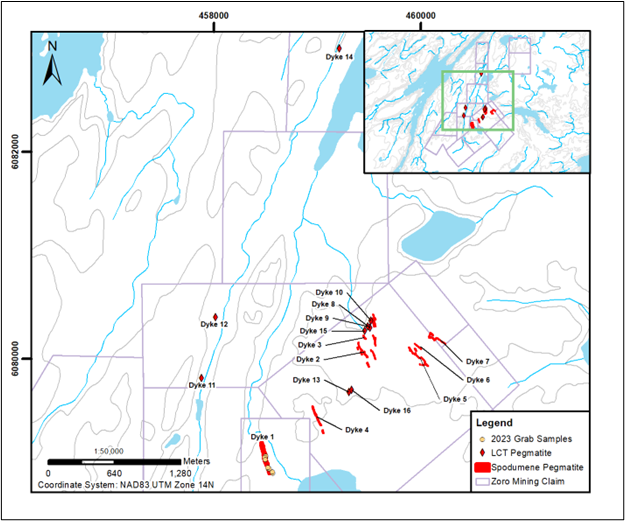
Figure 5. – Overview of the Zoro Property showing spodumene-bearing pegmatites and untested LCT pegmatites which are targets for future exploration.
Dahrouge Geological Consulting visited the mapped spodumene occurrence at Dyke 1 at the Zoro Property with a field crew during a summer 2023 exploration program for sampling and detailed structural mapping. Spodumene-mineralized pegmatite on surface at Dyke 1 was verified from 8 pegmatite samples, with 5 containing spodumene, returning values of up to 2.13% Li2O.
|
Sample ID |
Li (ppm) |
Li2O (%) |
Cs2O (ppm) |
Ta2O5 (ppm) |
|
153291 |
9883 |
2.13 |
161 |
44 |
|
153292 |
2627 |
0.57 |
178 |
44 |
|
153293 |
2979 |
0.64 |
147 |
60 |
|
153294 |
479 |
0.10 |
418 |
106 |
|
153295 |
5062 |
1.09 |
364 |
37 |
|
153296 |
6734 |
1.45 |
252 |
94 |
Table 1 – Assay highlights from grab samples taken on the Zoro property during the 2023 field program.
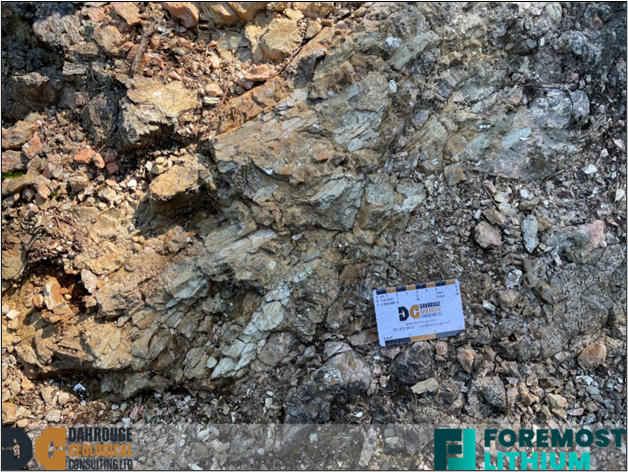
Photo 1 – Large spodumene crystals at Dyke 1 on the Zoro Property.
A drill program on Zoro will seek to expand the existing resource on Dyke 1, as well as further investigate the spodumene-bearing pegmatites on Dyke 8 and Dyke 16. Steps towards applying for a work permit and drill targeting are currently underway for this season’s winter drill program.
Winter Drill Program 2024
A 30-hole 7,500 winter drill program was announced on December 28, 2023. The focus of the drill program was Dyke 1, which had not been drilled since 2018 and is open along strike and at depth, providing Foremost the potential for excellent resource development. The mineralization on Dyke 1 is defined for 265 metres along strike and to a depth of 265 metres and attains widths of up to 40 metres.
On March 28, 2024, The Company provided an update to the drill program, reporting the widest drill intercept to date with an intersection of spodumene-bearing pegmatite at Dyke 1, spanning a cumulative length of 32.53 meters. Subsequent assay results completed on April 08, 2024 on two holes, FL24-009 and FL24-010, confirmed lithium mineralization spanning a cumulative length of 25.92m. (See map below for drill hole location)
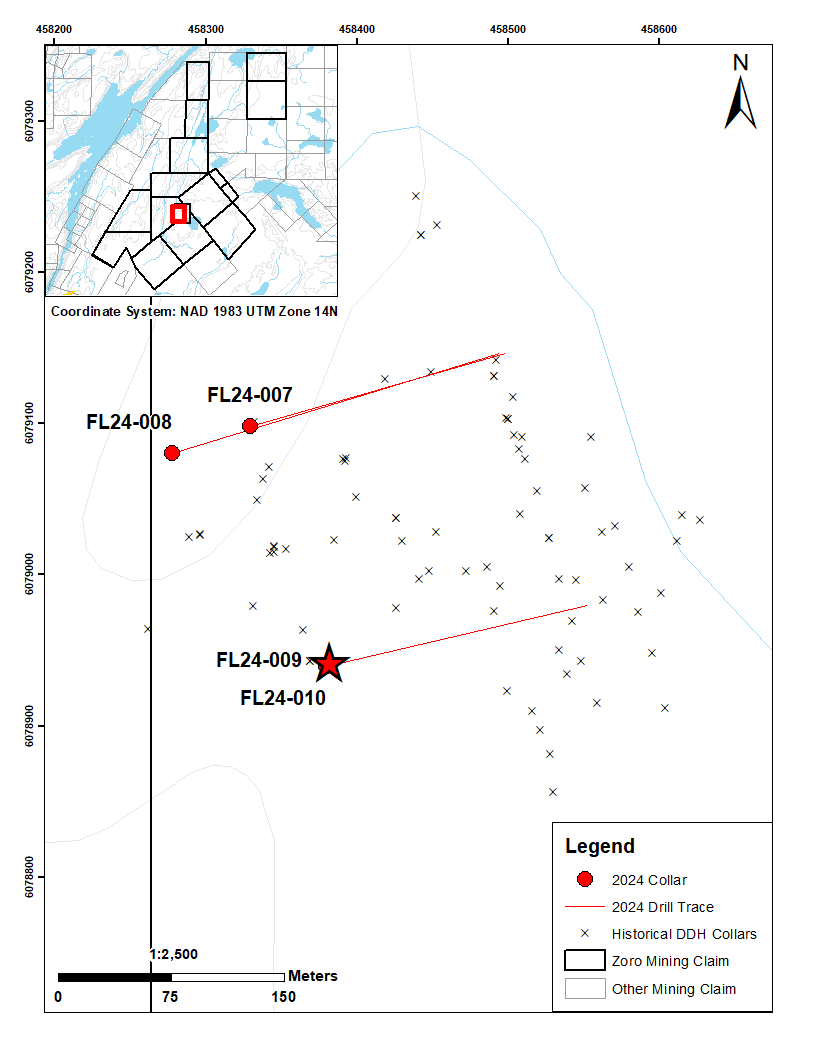
Figure 6: Zoro Dyke 1 Location Map Indicating Drill Hole Locations
Dyke 1 Drill Results
Drill results for the 2 drill holes completed at the Dyke 1 spodumene pegmatite are reported below in Table 2. These holes primarily target the depth extension of the pegmatite body. Results include:
• Drill hole FL24-009 intersected 7.96 m of spodumene-bearing pegmatite returning 1.03% Li2O starting at a depth of 233.04 m
• Drill hole FL24-009 intersected 5.02 m of spodumene-bearing pegmatite returning 1.52% Li2O starting at a depth of 235.98 m
• Drill hole FL24-010 intersected 9.88 m of spodumene-bearing pegmatite returning 1.09% Li2O starting at a depth of 77.57 m
• Drill hole FL24-010 intersected 5.37 m of spodumene-bearing pegmatite returning 1.34% Li2O starting at a depth of 180.73 m
| Hole number | Intersection | |||
| From (m) | To (m) | Width (m) | Li2O% | |
| FL24-010 | 176.22 | 186.1 | 9.88 | 1.09 |
| incl. | 176.22 | 179.48 | 3.26 | 1.08 |
| incl. | 180.73 | 186.1 | 5.37 | 1.34 |
| FL24-009 | 197.01 | 205 | 7.99 | 0.92 |
| and | 223.07 | 241 | 17.93 | 0.61 |
| incl. | 233.04 | 241 | 7.96 | 1.03 |
| incl. | 235.98 | 241 | 5.02 | 1.52 |
Table 2 - Interval Assay Results (Drill Holes FL24-009 & FL24-010
Dyke 1: New Lithium Extension
Mineralized drill intercepts confirm an extension of Zoro Dyke 1 in a new southern zone that was previously unexplored. The confirmation of well-mineralization lithium zones in new areas look favourable to expand the resource.
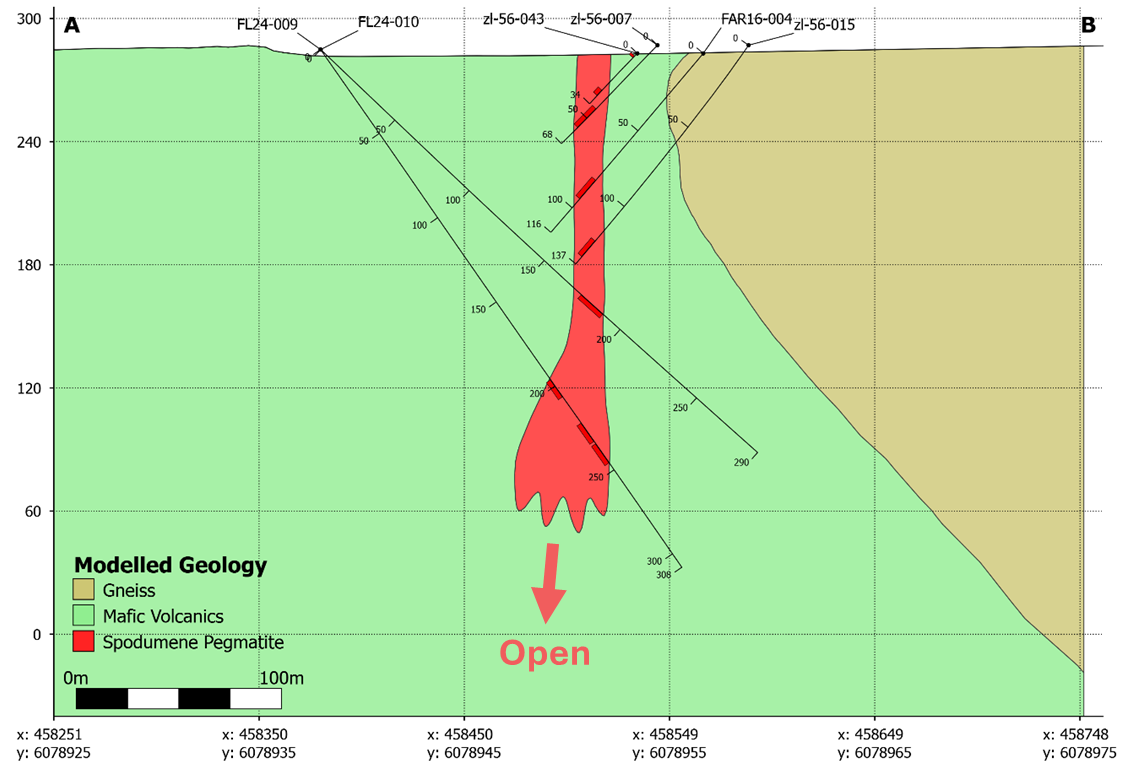
Figure 7: Zoro (Dyke 1) Cross Section of FL24-009, FL24-010 & Historical Drilling
Dyke 1 remains open at depth along its southern extension with focused drilling along this section. Company’s drilling efforts are expanding southward, aiming to explore and potentially increase the resource estimate by identifying new mineralized zones. Analytical results are still pending on the remaining drill core to date and will be reported upon analysis.
TANTALUM + NIOBIUM — INCREASING THE POTENTIAL VALUE OF ZORO
A high-grade drill intercept of tantalum (0.117 % Ta2O5 or 927 ppm tantalum; see November 1, 2017, news release [link]) was accompanied by elevated niobium in samples of drill core.
Currently, the significance of the elevated tantalum and niobium is unknown, but it will be closely assessed as Foremost Lithium exploration continues.
Tantalum is a rare, hard, blue-gray, corrosion-resistant metal that is widely used as a minor component in alloys. Tantalum is inert, making it a valuable substance for sensitive laboratory equipment and a substitute to platinum.
Tantalum exists alongside niobium, a chemically similar metal, which is also valuable. It is mainly used in alloys and is the largest metal in special steel, often used in gas pipelines. The stability of niobium-containing super alloys at high temperatures makes such alloys an important component in jet and rocket engines. Niobium is also used in various superconducting materials including the superconducting magnets of MRI scanners. Other applications of niobium include welding, nuclear industries, electronics, optics, numismatics, and jewelry.
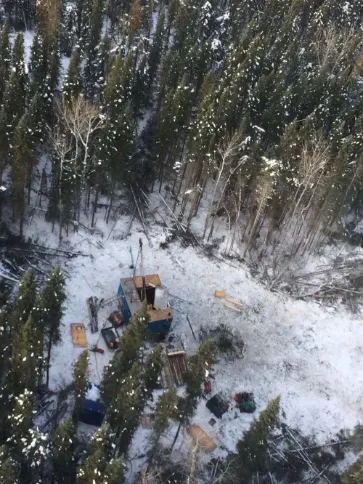
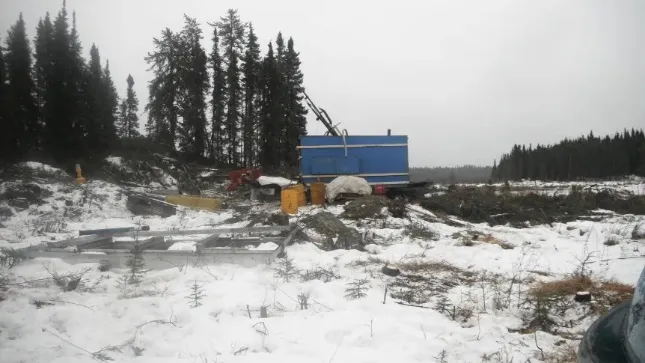
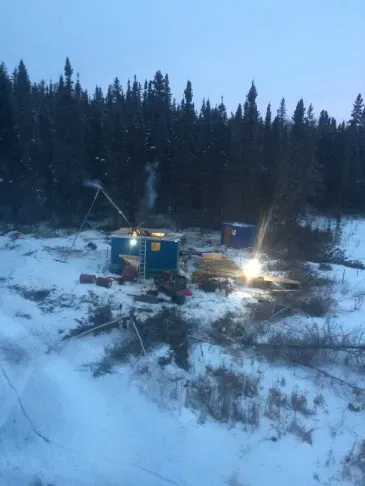
The renewable energy sector “metals-rich” green infrastructure is likely to spur investment and will boost the lithium market. Foremost Lithium’s Zoro Property is focused on expanding exploration and proving up high-grade lithium to address the current and future domestic lithium battery demand.
QP STATEMENT
Technical information relating to information contained on this property’s page has been reviewed and approved by Dr. Mark Fedikow, P.Geo. who is a Qualified Person as defined by NI 43-101.
